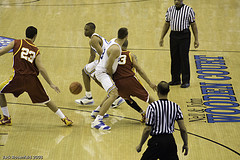Rubbing Shoulders on the Screen: Doing the Small Things Right
Rubbing Shoulders on the Screen in basketball is one of the simplest ways to increase the effectiveness of any team’s offense. Many teams utilise any number of different screening options in their general offensive play. Variations such as on-ball or off-ball are the two groupings that can discussed broadly, but there are many different techniques within these broad categories. Using the correct technique by rubbing shoulders on the screen has significant benefits for the individual player and the team in general.

One of the most noticeable benefits from rubbing shoulders on the screen is the ability for the player coming off the screen to increase the difficulty for the defender to guard them. By rubbing shoulders on the screen the defence has no option but to separate from the offensive player. In the instance where the defensive player must separate from the offensive player using the screen there are three options the defence will utilise; these are following behind the offensive player over the screen, going under the screen and switching with the screeners defender.
All of these tactics cause issues for the defence in covering the offensive cutter or dribbler using the screen. If the defensive player chooses to follow behind the offensive player then they are always at a disadvantage to recover as long as the offensive player cuts to the basket. This can create scoring options for the cutter/dribbler and in addition will trigger help defence rotations which will lead to other scoring opportunities.
If the defensive player chooses to go under the screen, the cutter or dribbler has the ability to receive an un-contested catch for an open shooting opportunity or even re-set the screen to create other options. This form of defence is especially problematic if guarding capable shooters. It should be noted that this will also tend to be a change-up tactic used by defences once the offence demonstrates its ability to continuously execute the rubbing shoulders on the screen. It is this change-up which should be a signal to the offensive team of the excellent execution of this technical aspect.
The final option highlighted is the defensive players switching between guarding the screener to guarding the cutter. Again this is often a tactic employed by coaches if a weakness in their ability to guard the use of the screen is continually exposed. The team needs to be aware of this tactic as it can then be utilised to create mismatches between players and expose additional scoring options as a result.
These direct and secondary scoring options for the cutter or dribbler are a constructive result of rubbing shoulders on the screen. Taking the time to utilise screens with the best possible technique will result in many more effective and efficient scoring opportunities.
So why is using a screen such a poorly performed skill? There is any number of reasons why, but probably the most obvious is because as coaches we often avoid the attention to this detail in preference to focusing on the big picture. Imagine how more efficient your offense would become if even just eighty precent of your strategy resulted in the correct technique of rubbing shoulders on the screen.
Simple technical points can make a significant difference to most offences, but watching all the items as a whole sometimes causes coaches to not see the small imperfections which can lead to the biggest improvement because these technical aspects are utilised so often. Teaching and then demanding constant performance of these small technical skills will bring great rewards.
The most significant benefit for an offensive team when performing the technique of rubbing shoulders on the screen is that it reduces even the most gifted defensive teams to a reactive style of basketball. This means teams with only a limited amount of offensive options can compete on a regular basis, day in, and day out.






Leave a Reply